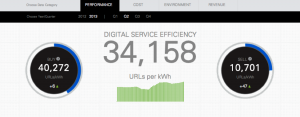Digital Service Efficiency
 Though it’s well understood you can’t manage what you don’t measure, the vast majority of enterprises don’t track the energy efficiency of their IT operations.
Firms spend tens of millions of dollars on data centers and energy usage, but seldom explore meaningful ways to manage this energy spend.
It gets shrugged off as “the cost of doing business.”
Though it’s well understood you can’t manage what you don’t measure, the vast majority of enterprises don’t track the energy efficiency of their IT operations.
Firms spend tens of millions of dollars on data centers and energy usage, but seldom explore meaningful ways to manage this energy spend.
It gets shrugged off as “the cost of doing business.”
 On an “about” page, written to explain the dashboard, eBay states:
Digital Service Efficiency offers a straight forward approach to measuring the overall performance of the eBay engine, its technical infrastructure, across four key business priorities: performance, cost, environmental impact, and revenue.
They go on to explain their goals, which include:
Increase transactions per kWh, Reduce cost per transaction, Reduce carbon per transaction
Digital Service Efficiency was created to be a precise measure of bottom-line IT energy efficiency. It identifies the amount of energy consumed for a single transaction. By using the denominator of actual business volume, the metric enables all forms of energy saving measures to be weighted and traded-off against each other—from more efficient CPUs, to better power usage effectiveness (PUE), right-sizing the data center, and coding to minimizes energy consumption.
On an “about” page, written to explain the dashboard, eBay states:
Digital Service Efficiency offers a straight forward approach to measuring the overall performance of the eBay engine, its technical infrastructure, across four key business priorities: performance, cost, environmental impact, and revenue.
They go on to explain their goals, which include:
Increase transactions per kWh, Reduce cost per transaction, Reduce carbon per transaction
Digital Service Efficiency was created to be a precise measure of bottom-line IT energy efficiency. It identifies the amount of energy consumed for a single transaction. By using the denominator of actual business volume, the metric enables all forms of energy saving measures to be weighted and traded-off against each other—from more efficient CPUs, to better power usage effectiveness (PUE), right-sizing the data center, and coding to minimizes energy consumption.
 Though it’s well understood you can’t manage what you don’t measure, the vast majority of enterprises don’t track the energy efficiency of their IT operations.
Firms spend tens of millions of dollars on data centers and energy usage, but seldom explore meaningful ways to manage this energy spend.
It gets shrugged off as “the cost of doing business.”
Though it’s well understood you can’t manage what you don’t measure, the vast majority of enterprises don’t track the energy efficiency of their IT operations.
Firms spend tens of millions of dollars on data centers and energy usage, but seldom explore meaningful ways to manage this energy spend.
It gets shrugged off as “the cost of doing business.”
Enter digital service efficiency.
In early 2013, eBay announced its Digital Service Efficiency (DSE) initiative and introduced a new metric. eBay explained in a post, Designing an Efficiency Metric, “We wanted to know if the data centers and computer systems were being used at the highest level of productivity and how to make them even more efficient.”
Today, eBay displays a variety of DSE statistics via an online dashboard for all the world to see.
It’s time for smart efficiency measures.
At RampRate, we’re optimistic more companies will begin taking DSE seriously. The concept aligns with vital imperatives: (1) controlling costs and (2) reducing carbon footprint. Of course, adopting DSE isn’t as easy as flipping a switch. Because every business is different, DSE needs to be fit a company’s business model. However, the framework and foundation of DSE establishes a smart starting point for setting standards to accomplish new energy efficiency initiatives.Digital Service Efficiency has been added to our index.
At RampRate, we’ve added DSE metrics to our SPY Index for full IT outsourced operations, PaaS, and online retail platforms. We’re working with companies higher up in the stack to track work and output on a per-transaction basis, wherever possible. We believe by indexing energy metrics, we can help business-level and financial decision makers identify misallocations in the budget by identifying the levers which most dramatically affect transaction costs. For example, one of RampRate’s gaming clients uses only 50% of their allocated power on average—compared to the industry-standard 75%. The reason they realize the power savings: servers are put on standby during off-peak hours. DSE is useful for measuring and reporting important figures such as the one cited here. Above all, it sets a standard for comparing efficiency across industries. Additionally, the metrics begin to enable financial analysts to predict performance.Will other firms follow suit?
Will DSE become the new “mile per gallon” of the IT industry? eBay hopes so—as does RampRate. DSE was created to be more meaningful than the power usage effectiveness (PUE) metric, which has never taken hold. The new metric goes deeper, making an end-to-end connection between what customers do and the fundamental business metrics they influence.Other firms have followed eBay’s example attempting to consume less power and reduce IT spend. However, like PUE, the use of Digital Service Efficiency has not yet been widely embraced.


